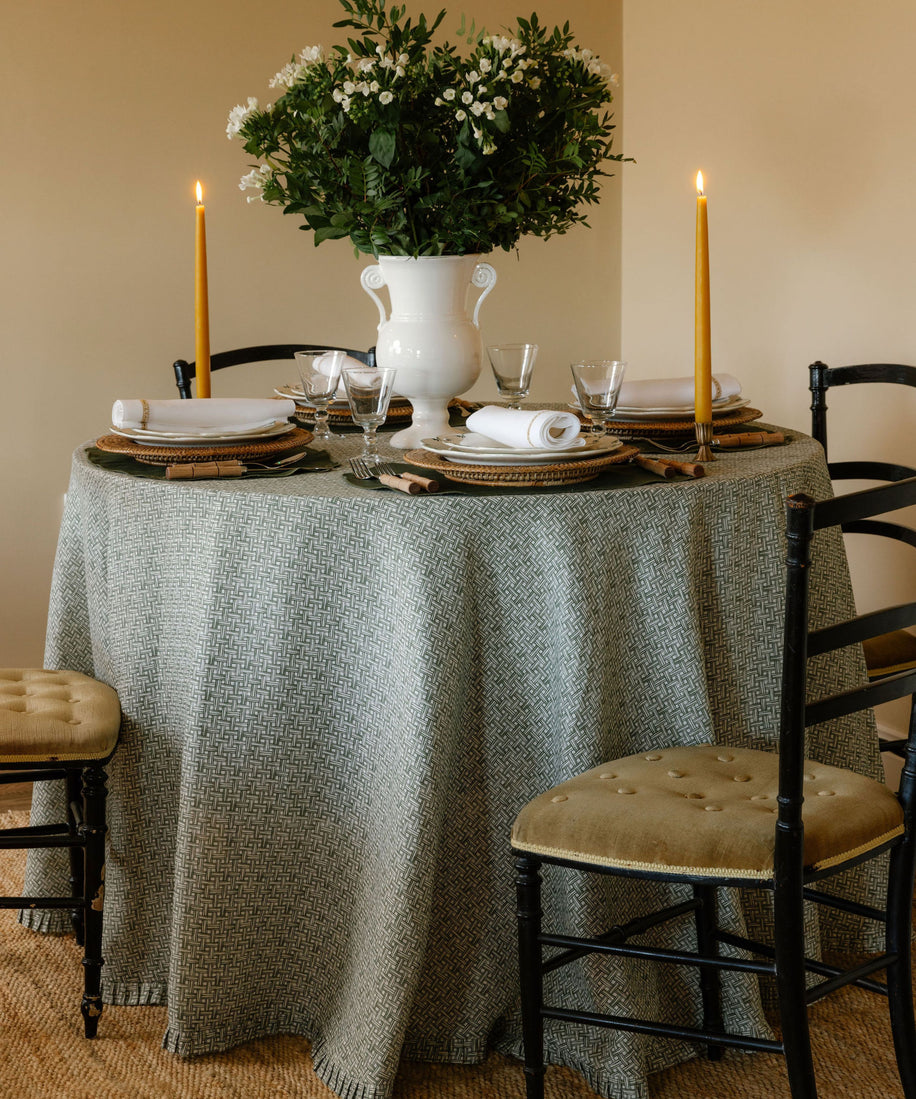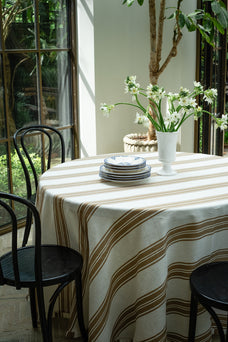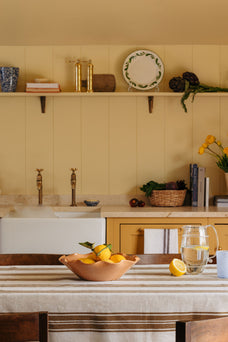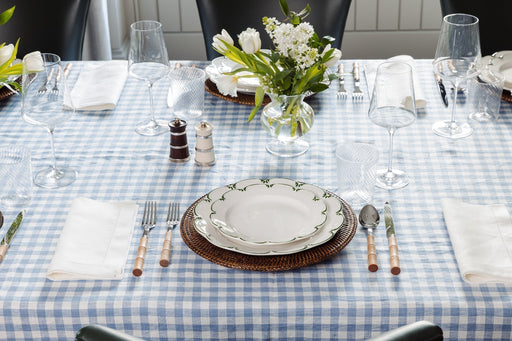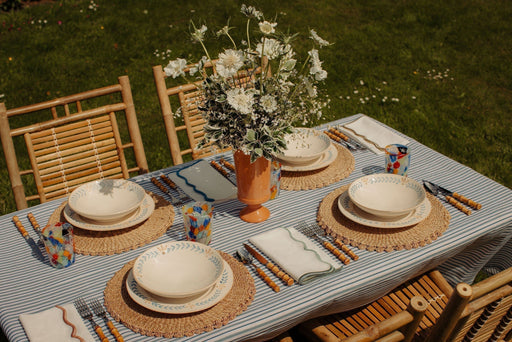All of the recipes in Ottolenghi’s brand new cookbook, COMFORT have been developed as new classics, that combine memories of childhood and travels into dishes to be cooked and enjoyed at home. Having thumbed through the book, Rebecca has chosen three recipes to share that would be ideal for a cosy and comforting early autumn meal.
Ottolenghi’s Puttanesca-style salmon bake is a simple yet effective main dish to serve at a dinner party, perfectly accompanied by Verena Lochmuller’s (Ottolenghi’s development chef) potato salad. Finally, we have Helen Goh’s (recipe developer and co-author) chocolate ripple fridge cake, a delicious dessert that you’ll want to leave room for!
All three recipes are extracted from Ottolenghi COMFORT by Yotam Ottolenghi, Helen Goh, Verena Lochmuller and Tara Wigley (Ebury Press, £30). All photography by Jonathan Lovekin.
Puttanesca-style salmon bake

Ingredients:
- 200g fine green beans, trimmed
- 6 spring onions, cut widthways into thirds (75g)
- 200g mixed cherry tomatoes, halved
- 6 skin-on salmon fillets (about 720g)
- Salt and black pepper
For the tomato anchovy oil:
- 85ml olive oil
- 8 anchovies, finely chopped (25g)
- 2 1/2 tbsp tomato paste
- 1 tsp chilli flakes
- 2 tsp coriander seeds, lightly bashed in a mortar
- 8 garlic cloves, very thinly sliced
- 2 preserved lemons, flesh and pips discarded, skin finely chopped (20g)
- 2 tsp maple syrup
For the salsa:
- 60g pitted Kalamata olives, halved 60g capers, roughly chopped
- 1 preserved lemon, flesh and pips discarded, skin thinly sliced (10g)
- 10g basil leaves, roughly chopped
- 10g parsley leaves, roughly chopped
- 2 tbsp olive oil
- 2 tsp lemon juice
If you make the tomato anchovy oil a day ahead here, you can then delight in the fact that a midweek supper can be on the table within 20 minutes. The fuss-free cooking method – all hail the traybake! – plus the dialled-up flavours – all hail puttanesca! – makes such a winning combination.
Serves 4
Method:
First make the tomato anchovy oil. Put the oil, anchovies and tomato paste into a small sauté pan and place on a medium heat. Once the mixture starts to simmer, cook for 5 minutes, stirring from time to time. Add the chilli flakes and coriander seeds and cook for another minute, until fragrant. Remove from the heat and add the garlic, preserved lemon and maple syrup. Stir to combine, then set aside to cool.
Preheat the oven to 220°C fan.
Place the beans, spring onions and tomatoes on a large, parchment-lined baking tray. Drizzle over 3 tablespoons of the tomato anchovy oil, along with ¼ teaspoon of salt and a good grind of pepper. Toss to combine and place in the oven for 12–13 minutes, until the beans and tomatoes are starting to soften and taking on a little colour. Meanwhile, arrange the salmon fillets on a plate and, using a spoon, drizzle the remaining tomato anchovy oil (as well as all the solids) evenly over the fillets. Once the beans and tomatoes have had their time in the oven, nestle the salmon fillets among them and bake for a further 8 minutes. Set aside for 5 minutes, out of the oven, to rest.
While the salmon is baking, mix all the ingredients for the salsa in a small bowl and season with a good grind of pepper. Spoon half the salsa over the salmon and serve the fish warm (or at room temperature, which works just as well), with the rest of the salsa in a bowl on the side.
Serve on:
Lean into the Italian theme of the dish, serving on our Italian-crafted Olivia scalloped dinner plates.
Verena’s potato salad

Ingredients:
- 500g Pink Fir or Charlotte (or other waxy) potatoes
- 75ml olive oil
- 1 small onion, finely chopped (125g)
- 1 garlic clove, crushed
- 175ml chicken stock
- 2 tsp Dijon mustard
- 2 tbsp apple cider vinegar
- 1/2 tsp black peppercorns, coarsely crushed in a pestle and mortar
- 15g chives: 10g finely chopped and 5g cut into 1½cm lengths
- 75g pack of diced smoked pancetta
- 1 tsp paprika
- 1/4 cucumber, sliced lengthways, deseeded and cut into ½cm dice (100g)
- Salt
Growing up in Germany, Verena remembers two camps when it came to potato salad: camp mayo and camp oil/broth. This is an oil/broth-based version, more prevalent in the southern parts of Germany, specifically Swabia and Bavaria. It’s less heavy and claggy than the mayo variety and gets its creaminess from the starch released by the potatoes as they sit for a couple of hours in the warm broth. We’ve strayed from tradition and added some pancetta (because, why not . . . ) and a welcome freshness from some chopped cucumber.
Serves 4
Method:
Put the potatoes into a medium saucepan, for which you have a lid. Add just enough water to cover, salt generously and place on a medium-high heat. Bring to the boil, then reduce the heat to medium-low and cook, covered, for 20–25 minutes, until just tender. Drain and, once cool enough to handle, remove the skins from the potatoes and slice into ½cm-thick rounds. Set aside in a medium bowl.
Put 2 tablespoons of the oil into a medium sauté pan and place on a medium heat. Add the onion and cook for 12–15 minutes, stirring regularly, until caramelised. Add the garlic and stock, bring to a simmer, then remove from the heat. Add the mustard, vinegar, 1¼ teaspoons of salt, the pepper and another 2 tablespoons of oil. Whisk to combine, then pour the mixture over the potatoes. Mix gently but thoroughly: it will look wet (and some of the potatoes will break up), but this is normal. Set aside for about 2 hours, for the potatoes to soak up about half the broth, and then stir in the finely chopped chives.
Meanwhile, wipe clean the sauté pan and place on a medium-high heat. Add the pancetta, reduce the heat to medium-low and cook for 10–12 minutes, stirring occasionally, until the pancetta is crispy. Using a slotted spoon, transfer to a plate lined with kitchen paper – leave about 1 tablespoon of the fat in the pan – and set aside. Once cool, finely chop the pancetta into crumbs.
Add the remaining tablespoon of oil to the fat in the pan, along with the paprika. Stir for 30 seconds or so, until fragrant, then remove from the heat.
When ready to serve, fold the cucumber into the potato salad and transfer to a serving plate. Scatter over the pancetta crumbs, along with the cut chives. Spoon over the paprika oil and serve.
Serve on:
Present in a serving bowl or platter for guests to help themselves, encouraging a convivial atmosphere around your table.
Chocolate ripple fridge cake

Ingredients:
- 3 tbsp milk (or 105ml if not using the Grand Marnier)
- 60ml Grand Marnier (if using)
- 1 espresso shot, regular or decaf (30ml)
- 650ml double cream
- 325g crème fraîche
- 50g icing sugar
- 1 1/2 tsp vanilla extract
- 1 1/2 tsp ground cinnamon
For the biscuits:
- 225g plain flour
- 50g cocoa powder
- 3/4 tsp baking powder
- 1/2 tsp bicarbonate of soda
- 1/4 tsp salt
- 100g unsalted butter, at room temperature
- 200g caster sugar
- 50ml vegetable oil
- 50g golden syrup
- 1 egg
For the macerated strawberries:
- 600g strawberries, hulled and quartered
- 1 1/2 tbsp caster sugar
- 1 tsp finely shaved orange zest
- 2 tbsp Grand Marnier (or orangejuice)
- 2 strips of orange zest, julienned
As anyone who’s ever been to an Australian barbecue will know, chocolate ripple cake is a ubiquitous, no-bake dessert. In Australia, it’s made with shop-bought chocolate biscuits which are then sandwiched together with cream. The recipe is so simple that it’s printed on the back of the biscuit packet! On a recent family trip back to Melbourne, Helen’s kids were so taken by the cake that they begged her to make it back in London. Not being able to get hold of the right biscuits – Arnott’s Choc Ripple (though they are now available online) – Helen made them from scratch. They’re so quick and simple to bake that Helen now not only bakes them to make the cake but, also, makes extra biscuits to have around. No birthday party (or barbecue!) is complete without them.
Getting ahead: The biscuits can be made and baked up to 7 days in advance, kept in an airtight container. The cake needs to be made up to 6 hours before serving, to allow it to soften and meld together, but can be made up to 2 days in advance, left to sit and wait in the fridge.
Playing around: The strawberries work really well here but, as an alternative, just crumble over another cookie or a chocolate flake.
Serves 8–10
Method:
First make the biscuits. Sift the flour, cocoa powder, baking powder, bicarbonate of soda and salt into a medium bowl.
Place the butter, sugar, oil and golden syrup in the bowl of a stand mixer with the paddle attachment in place. Beat on a medium speed for 2 minutes, until light and creamy. Scrape the sides of the bowl, then add the egg and beat again until combined. Reduce the speed to low, add the dry ingredients and mix until the dough comes together. Wrap and chill in the fridge for at least 2 hours.
When ready to bake, preheat the oven to 170°C fan.
Pinch off 30g pieces of dough and roll them into balls, then place them, spaced about 5cm apart, on two large parchment-lined baking trays. You should make about 23 balls. Flatten them with your hand – they should be about 5cm wide – then bake for 15 minutes, until firm and the tops are cracked or ‘rippled’. Remove from the oven and allow to cool for 5 minutes before transferring to a wire rack to cool completely.
When ready to assemble the cake, combine the milk, Grand Marnier (if using) and espresso and set aside.
Place the cream, crème fraîche, icing sugar, vanilla extract and cinnamon in the bowl of the stand mixer with the whisk attachment in place. Whisk on a medium-high speed until soft peaks form: be careful not to over-whip, as the cream will thicken as you spread it. Transfer 200g of the mixture to a small bowl and refrigerate: this will be used to finish the cake. Pipe or dollop a roughly 30cm-long line (about 2cm wide) of the remaining cream mixture down the centre of a long cake plate or board: this is to help position the biscuits for assembly.
Take 20 of the biscuits and, working with one biscuit at a time, lightly brush both sides with the milk mixture: you want to just moisten the entire biscuit without drenching it. Then, using a small spatula or knife, spread 2 tablespoons of the cream on one side of the biscuit. Standing the biscuit upright, press it down on to one end of the strip of cream. Repeat with another biscuit, then place alongside the first biscuit, pressing to sandwich them together. Continue with the remaining biscuits to form a long log cake. Spread the remaining cream mixture over the top and sides of the log: don’t worry if it only barely covers the cake, as it will be topped up with the reserved cream the following day. Cover loosely and refrigerate for at least 6 hours or overnight.
About 15 minutes before you’re ready to serve, combine the strawberries in a bowl with the sugar, finely shaved orange zest and Grand Marnier. Leave to macerate for 10–15 minutes.
Meanwhile, spread the reserved cream over the top and sides of the log.
When ready to serve, tumble about half the strawberries along the top of the cake, pressing them on slightly to help them stick. Drizzle any syrup over and around the plate. Finish with the orange zest strips on top. When serving, slice on the diagonal – warming the blade of the knife in a jug of hot water helps with the ‘cleanness’ of the slice – to reveal the stripes.
Serve on:
Our chocolate brown Josephine dessert plates are ideal for presenting this deliciously rich and chocolatey cake.

